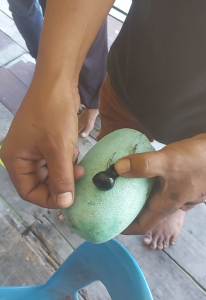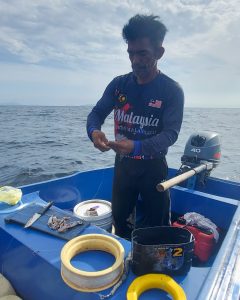 An interview with Roy Bealey, IPNLF Fisheries Director on exploring new opportunities and expanding their work territories.
An interview with Roy Bealey, IPNLF Fisheries Director on exploring new opportunities and expanding their work territories.
As Fisheries Director for IPNLF, part of Roy Bealey’s work is to establish fishing site viability in various locations around the world. It’s an arduous role as he is often on the road for weeks at a time visiting locations with little or no modern infrastructure. A fisherman at heart, Roy makes it look all too easy and after a number of weeks on the road, he recently returned from a visit to a remote fishing community on Mabul Island in Malaysia. IPNLF Communications Manager, Stuart caught up with him to chat about his experiences and gain a better understanding of the need to visit these remote sites.
Hi Roy, so can you tell us a bit about what you do at IPNLF and why Mabul Island?
Site visits like this are an integral part of what we do at IPNLF in the hopes of empowering responsible fisheries which give back to the seas and the people that depend on them. An important part of my role at IPNLF is to scope out new geographies where we can potentially roll out new projects in line with the support received from the Common Oceans Tuna project and its ambitions to make sure that all major tuna stocks are fished at sustainable levels by 2027. As we collectively navigate complexities of the industry, we strive to ensure that these fishers’ efforts are recognized, their catch valued, and their livelihoods preserved for generations to come.
Tell us about Mabul Island
On my visit to the site I was able to experience firsthand the intricacies of the local fishing market, the fishers practices, the obstacles they encounter, and their aspirations for a more sustainable future. I wanted to gain a better understanding of their fishing methods, current harvest volumes, handling and cold chain practices, pricing structures and current market dynamics. Getting a better understanding of these factors can help us identify opportunities to implement our Fisheries Improvement Toolbox (FIT) or even connect the fishery to IPNLF’s member network that may be looking to source from this area in future.
What were some of the stand out things you saw?
 Like other fisheries we work with, the fishers of Mabul Island rely on time-honoured handline fishing techniques to target yellowfin tuna. This method of handline fishing has been passed down from generation to generation, and learnt by experience. It was encouraging to see them employing circle hooks along with their drop rock method of targeting larger tuna while avoiding bycatch. Something quite unique is the way the fishers use a small packet of squid ink that is punctured with a line pin attached to the mainline before deploying their bait. When the rock and bait sinks to the desired depth and the line is pulled to release the rock, this also pulls the pin out of the ink packet to disperse ink and imitate a stressed squid response.
Like other fisheries we work with, the fishers of Mabul Island rely on time-honoured handline fishing techniques to target yellowfin tuna. This method of handline fishing has been passed down from generation to generation, and learnt by experience. It was encouraging to see them employing circle hooks along with their drop rock method of targeting larger tuna while avoiding bycatch. Something quite unique is the way the fishers use a small packet of squid ink that is punctured with a line pin attached to the mainline before deploying their bait. When the rock and bait sinks to the desired depth and the line is pulled to release the rock, this also pulls the pin out of the ink packet to disperse ink and imitate a stressed squid response.
Live bait, when available, is the bait of choice for these fishers but sometimes they make use of glow-in-the-dark jigs to target larger fish at night. They also use dead squid baits they catch alive themselves in the fishing grounds before first light each morning, and they make buoys that they can quickly attach to their handline before throwing it overboard if they hook a fish too big to fight within one spool of line. These fishers are drawing on a depth of knowledge and tradition when it comes to targeting tuna, and it’s always a pleasure to learn how communities refine these traditional fishing techniques over time.
I also learned that when they catch a large tuna, they will sometimes call the buyer and return to Semporna (mainland town) with that fish immediately if the buyer offers them a good price for it, rather than continuing to fish for more volume. This sets a good precedent, but time will tell if it will be possible to have that trader lead and drive future quality improvements while also equitably sharing the financial benefits gleaned from improved end market opportunities with the fishers.
What are some of the common challenges that this community is facing?
Many of these remote communities face similar challenges like ice scarcity, unfair market dynamics, and limited control over the value chain. There are many hurdles that they need to overcome and it was inspiring to see the fishers’ determination to overcome these issues and establish a collective voice. A critical challenge faced by these fishers is the limited availability of ice on their island. Their only current solution is to endure a 45-minute boat journey to Semporna in search of ice before each fishing trip. This not only incurs additional costs but also eats into their valuable fishing time. With aspirations for better access to ice, the fishers hope for local and external support to address this issue, minimising fuel costs, and preserving the quality of their harvests.
 The fishers on Mabul Island operate as price takers, with their hard work often going largely unrewarded due to fluctuating market demands. The main shortcoming of the current fishery is that its market system does not pay premiums for quality, and the fishers are therefore incentivised to focus on maximising their catch volumes more than focusing on the quality and ultimate value of their tuna at landing. They express frustration with their limited control over prices, yearning for a fairer system that will value a high-quality catch. That being said, the fishers also recognize the potential for improved market access and are exploring the establishment of a fisher association, which should allow them to collectively negotiate prices and promote their responsible fishing practices in the hopes of engaging export markets that will appreciate their commitment to quality following the best practices that IPNLF can teach them.
The fishers on Mabul Island operate as price takers, with their hard work often going largely unrewarded due to fluctuating market demands. The main shortcoming of the current fishery is that its market system does not pay premiums for quality, and the fishers are therefore incentivised to focus on maximising their catch volumes more than focusing on the quality and ultimate value of their tuna at landing. They express frustration with their limited control over prices, yearning for a fairer system that will value a high-quality catch. That being said, the fishers also recognize the potential for improved market access and are exploring the establishment of a fisher association, which should allow them to collectively negotiate prices and promote their responsible fishing practices in the hopes of engaging export markets that will appreciate their commitment to quality following the best practices that IPNLF can teach them.
With that in mind, the government, be it Federal or State Agencies, need to invest in infrastructure improvements and improve the regulations relevant to the trading of tuna. With improved regulations, all stakeholders will put more emphasis on the importance of fish quality which could ultimately improve trade opportunities, not only in Malaysia, but potentially also to global markets.
What was a key takeaway from your trip to Mabul?
Despite the challenges they face, the fishers of Mabul remain united in their vision for a sustainable future. Their adherence to traditional fishing practices reflects their commitment to responsible resource management in their local waters. The challenges they face, particularly in relation to ice scarcity and market dynamics, highlight the need for external support. It may be possible that through training programs, capacity building initiatives, and collaboration with stakeholders, they would be able to improve their market opportunities and secure better prices for their tuna.
Thanks Roy.
Some interesting trip stats: